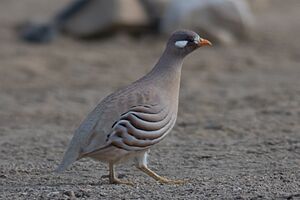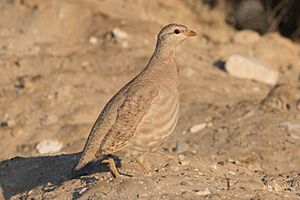Sand partridge facts for kids
Quick facts for kids Sand partridge |
|
|---|---|
 |
|
| Conservation status | |
| Scientific classification | |
| Genus: |
Ammoperdix
|
| Species: |
heyi
|
The sand partridge (Ammoperdix heyi) is a type of gamebird that belongs to the pheasant family, called Phasianidae. These birds are part of a larger group known as Galliformes, which includes chickens and turkeys.
You can find the sand partridge mainly in places like Egypt and Israel, stretching east into the southern part of the Arabian Peninsula. It looks a lot like its close relative, the see-see partridge, which lives in southeast Turkey and east to Pakistan.
This bird is about 22–25 centimeters (9-10 inches) long. It lives in dry, open, and often hilly areas. Sand partridges build their nests on the ground, laying 5–14 eggs. They eat many different kinds of seeds and some insects.
Contents
What Does a Sand Partridge Look Like?
The sand partridge is a round-shaped bird, mostly sandy-brown. It has wavy white and brown stripes on its sides. These birds are about 22-25 cm (9-10 inches) tall and weigh around 180-200 grams (6-7 ounces). Their wings can spread out to 39–41 cm (15-16 inches). They can live for up to 4 years.
When something bothers them, sand partridges usually prefer to run away instead of flying. But if they need to, they will fly a short distance using their rounded wings. Their song sounds like a slurred kwa-kwa-kwa.
How Male and Female Sand Partridges Are Different
Male sand partridges are a bit bigger than females. Males have orange beaks, while females have dull yellowish ones. The male has a grey head with a white stripe in front of its eye and a white patch on its cheek. The sides of its neck are plain, without white spots. This head pattern helps tell them apart from the see-see partridge.
Female sand partridges look like a faded version of the males. They are more sandy and grey, with fewer markings. They have pinkish bars instead of white spots on the side of their neck. It's harder to tell female sand partridges apart from their relatives because their head patterns are not as clear. Young sand partridges, both male and female, look like adult females.
Where Do Sand Partridges Live?
Sand partridges are found only in the Middle East. You can see them in Eastern Egypt, Eastern Sudan, Israel, Jordan, Saudi Arabia, Yemen, Oman, and the United Arab Emirates (UAE). There are four different types (subspecies) of sand partridges, and each lives in specific parts of the Middle East.
For example, one type, Ammoperdix heyi heyi, lives from the Jordan Valley to the Egyptian Sinai Peninsula and into Saudi Arabia. Another type, Ammopredix heyi nicolli, is found in Northern Egypt.
What Kind of Places Do They Like?
Sand partridges live in desert areas that have some plants and rocks scattered around. They like steep, rocky slopes with sandy valleys (called wadis) and ridges. They can live in places as high as 2000 meters (about 6,500 feet) and as low as 400 meters (about 1,300 feet) below sea level.
You won't often find sand partridges in large, flat, or empty desert areas. This is because they need a source of water to drink. Sand partridges do not migrate, meaning they stay in these habitats all year long to breed and live.
Sand Partridge Behavior and Life
How Sand Partridges Communicate
Only male sand partridges are known to make certain calls. Their signaling call sounds like "kew-kew-kew" or "watcha-watcha-watcha". If they get scared or are forced to fly, they make a louder, higher sound like "quip" or "qu-ip," or a harsh "wuit-wuit-wuit."
What Do Sand Partridges Eat?
Sand partridges are omnivores, which means they eat both plants and insects. In the summer, they mostly look for seeds and berries. Seeds often come from Acacia trees and different grasses. Berries come from plants like the toothbrush tree (Salvadora persica) and myrrh plants (Commiphora species). The insects they eat are mostly locusts.
In the Arabian Peninsula, sand partridges also eat leaves and buds from plants like desert thorn (Lycium shawii), Rhazya stricta, and Sideroxylon mascatense. Places with woody plants that are 2–3 meters (6-10 feet) tall among rocks are great for them to find food. These spots also offer good hiding places from predators.
Sand Partridge Reproduction and Life Cycle
The breeding season for sand partridges depends on where they live. In Israel, they breed between February and August. In Jordan and the Sinai region of Egypt, eggs are laid in March and April. In Northern Africa, eggs are laid only in April. In the Arabian Peninsula, eggs are mostly laid in March and April, but sometimes as late as August to November in Oman and Yemen.
Sand partridges are likely monogamous, meaning one male mates with one female. However, nests have been found close together (30-70 meters apart) in Israel, which might mean one male sometimes mates with more than one female (a behavior called polygyny).
They build their nests in a few different ways:
- Sometimes, they line the nest lightly with grass, feathers, small pieces of wood, or pebbles.
- Other times, they build the nest under a bush or rock and leave it unlined.
- They might also build nests in hollows or cracks at the bottom of cliffs.
Females lay between 5–14 eggs, which are pale grey or pink. Sometimes, two females might lay eggs in the same nest. Only the female bird sits on the eggs to keep them warm, which takes about 21–24 days.
When the chicks hatch, they are white with a grey upper chest and a pale throat. Chicks can start to fly (called fledging) when they are 9–20 days old. They are fully grown by 30 days. Sand partridges can be found in groups of a dozen birds. Sometimes, families come together to form large flocks of up to 70 birds in late summer or early autumn.
How Sand Partridges Are Protected
The sand partridge is listed as 'Least Concern' by the IUCN Red List. This means that their population is not in danger. They live across a large area and are common and stable in the regions where they reside.
Sand partridges have been introduced to two islands near Saudi Arabia and the UAE. It's estimated that there are about 900,000 pairs of sand partridges in Arabia, and their numbers are growing. Sand partridges live in areas that are mostly not suitable for humans, so they face very few threats.
Things like animals grazing, cities growing, droughts, and climate change can affect sand partridges, but these are not major threats to their overall population. People also hunt sand partridges for sport and food in some areas. There are conservation sites across the sand partridge's habitats. In Jordan, a group called the Jordan Outdoor Sport Association was started in 2014 to encourage sustainable hunting. They even release sand partridges to help keep the population strong.




